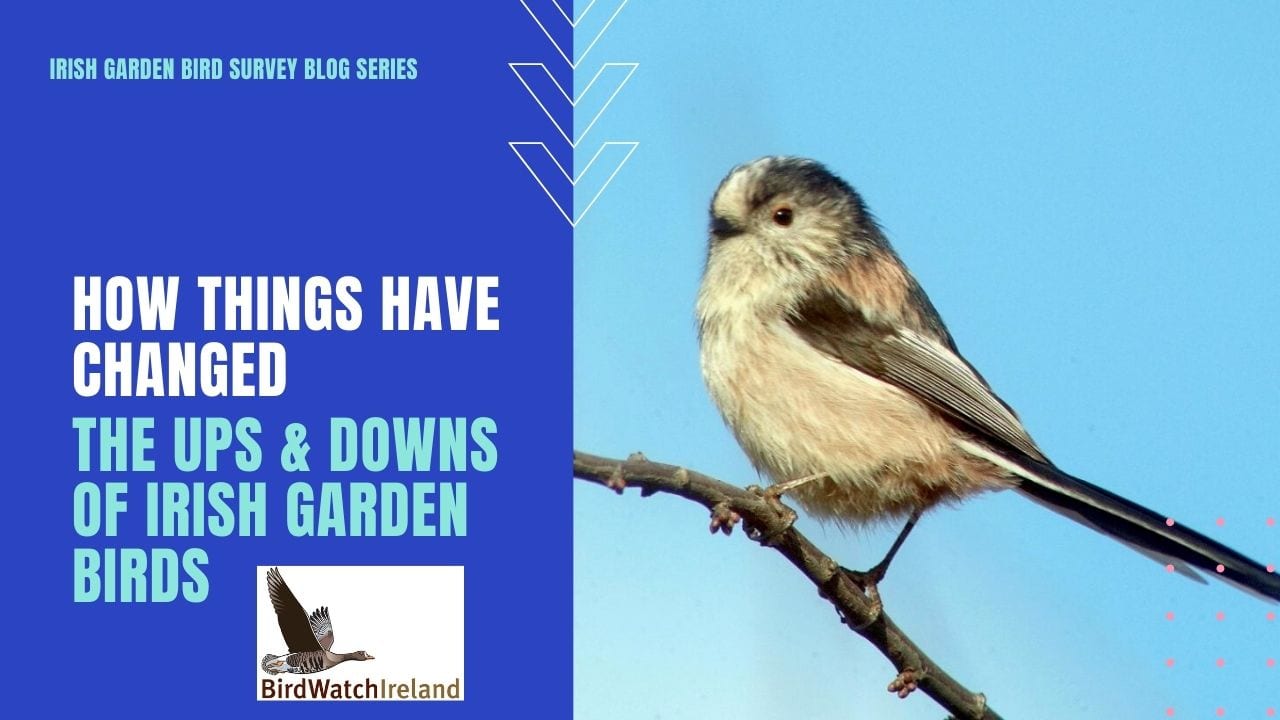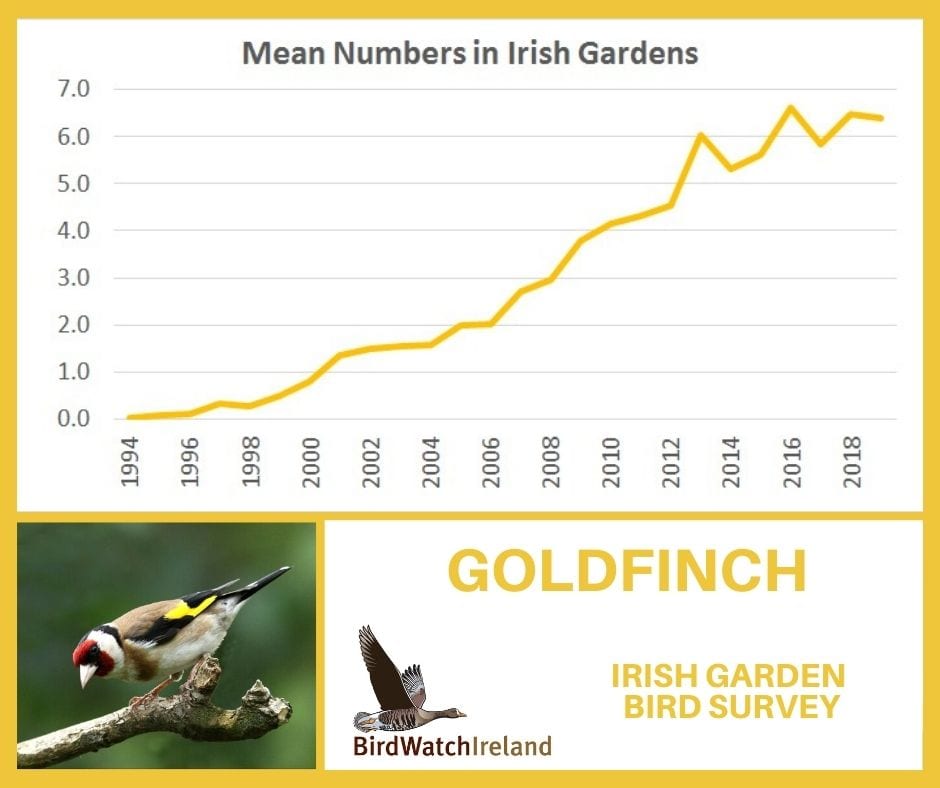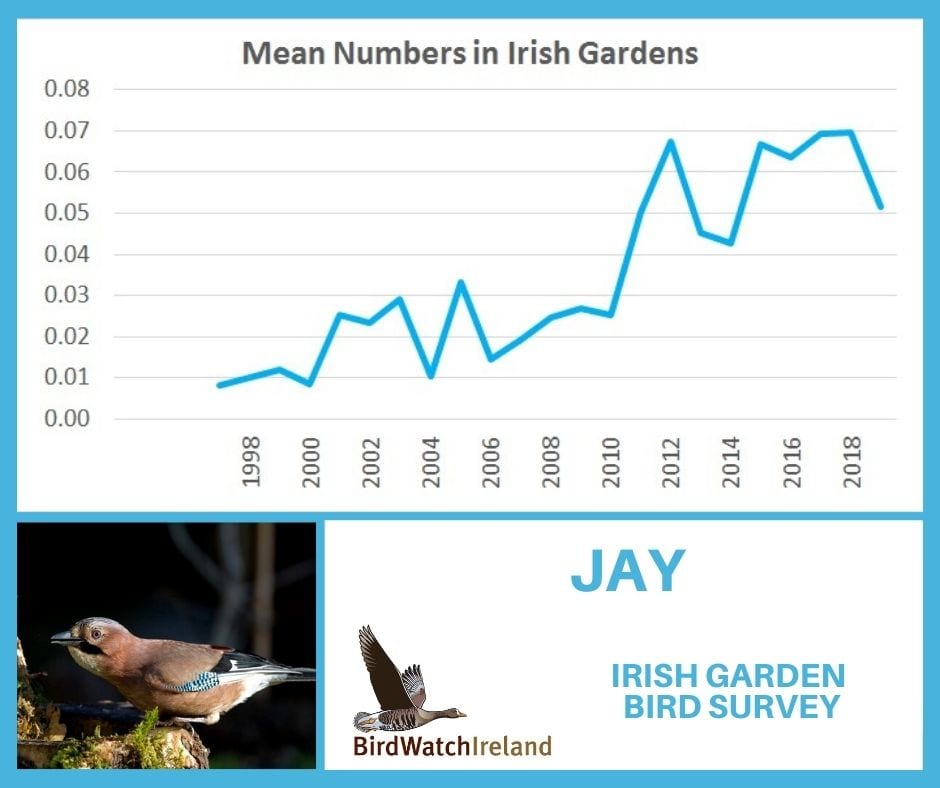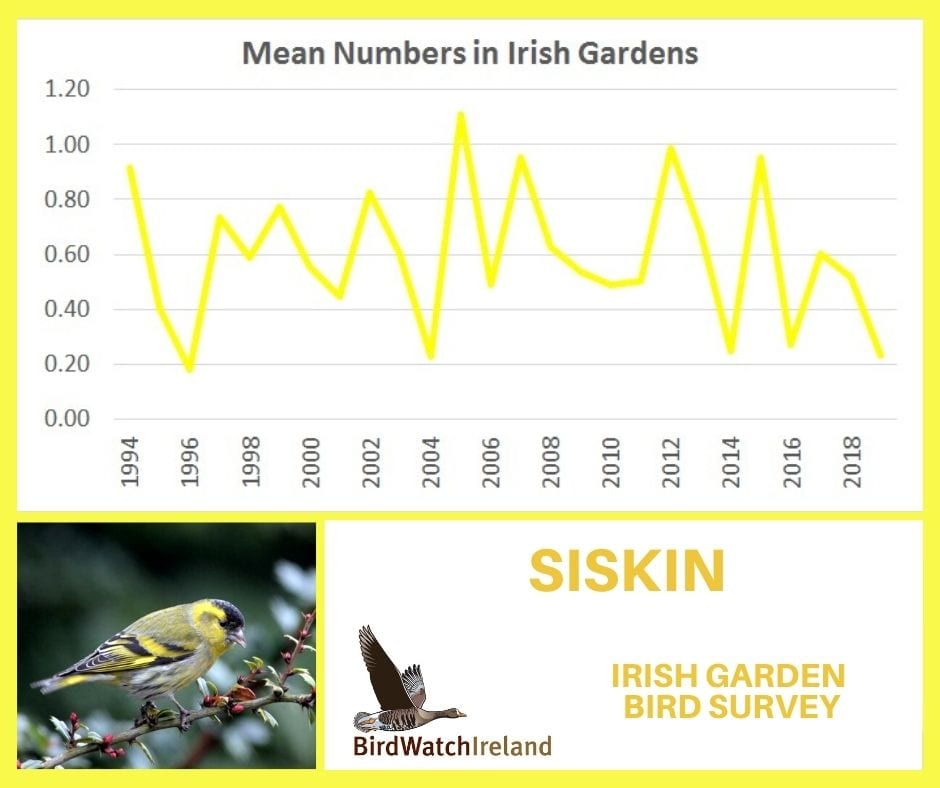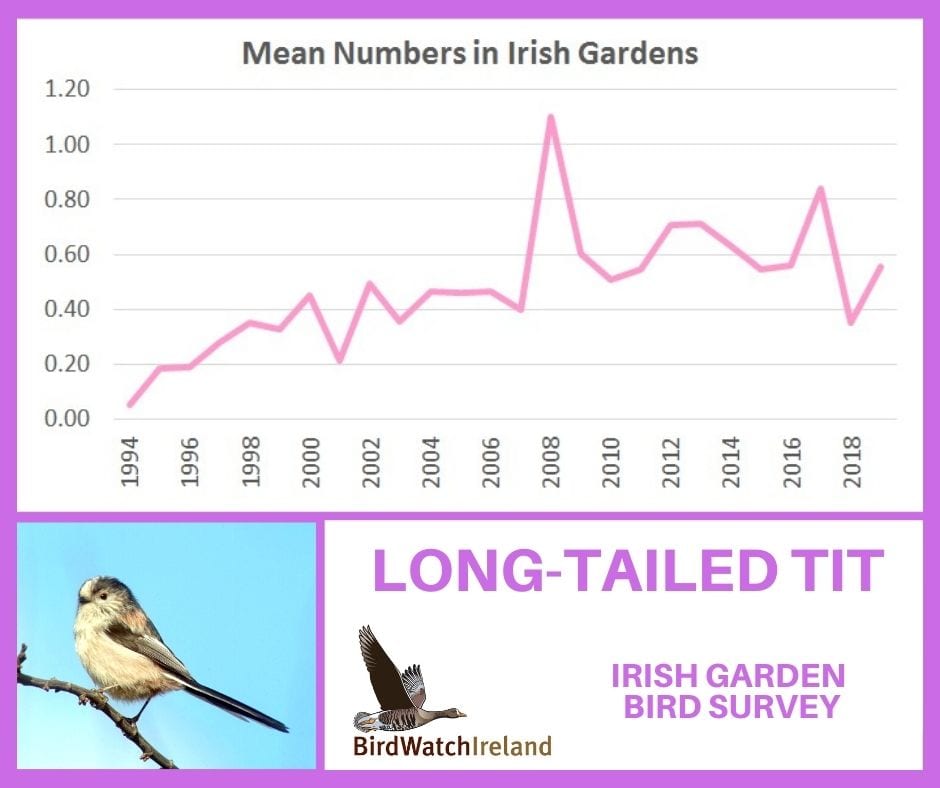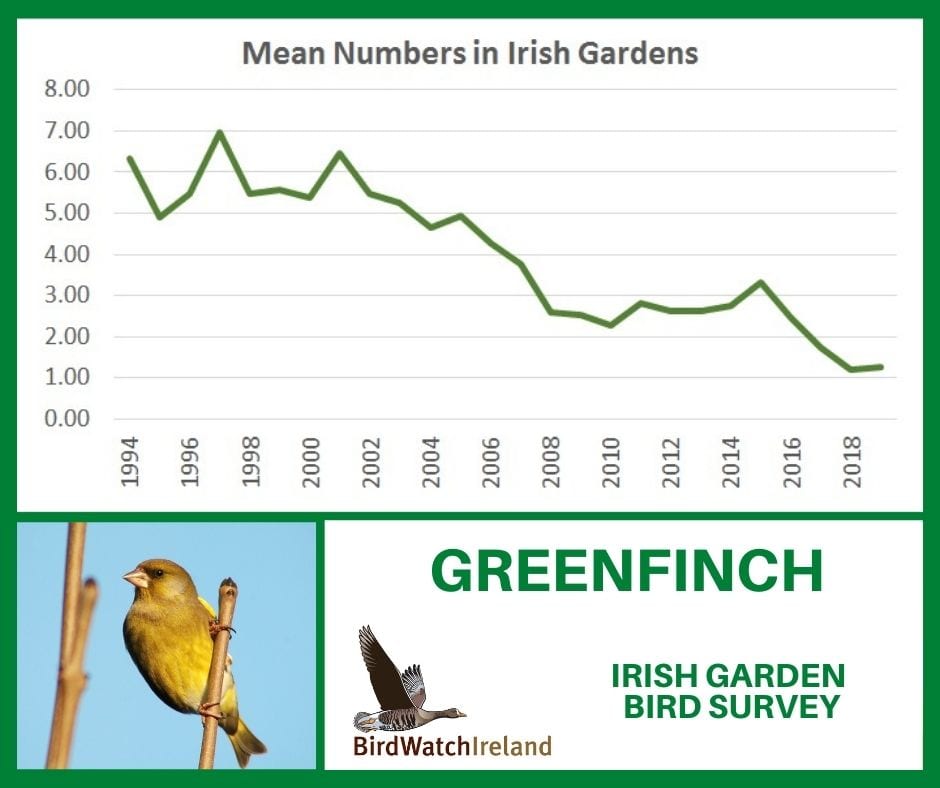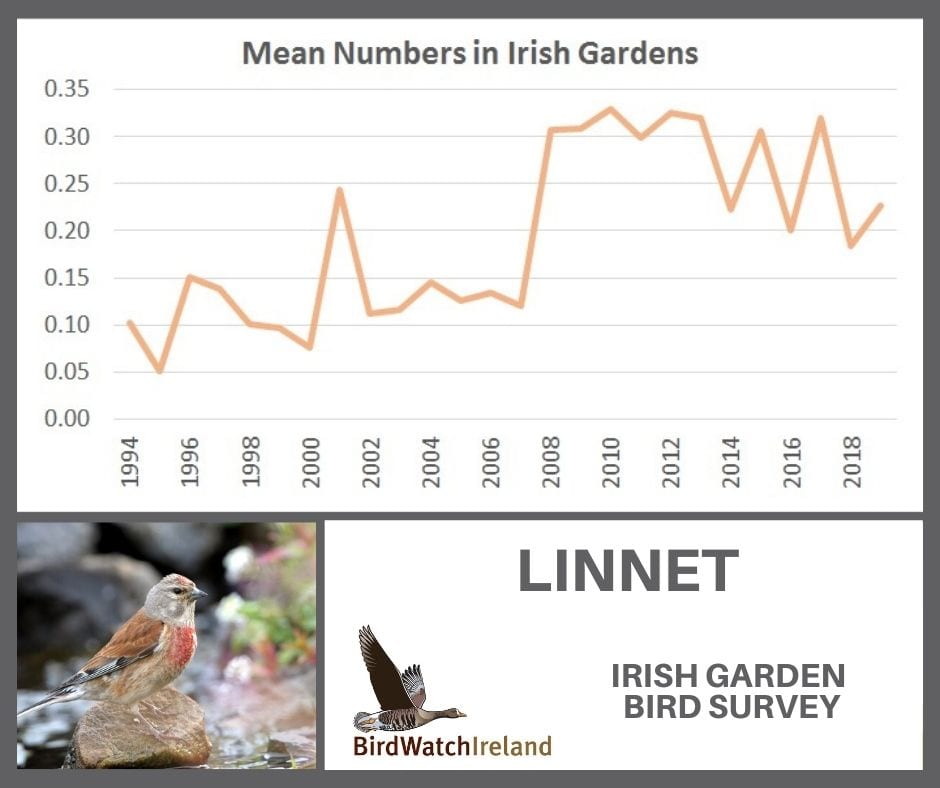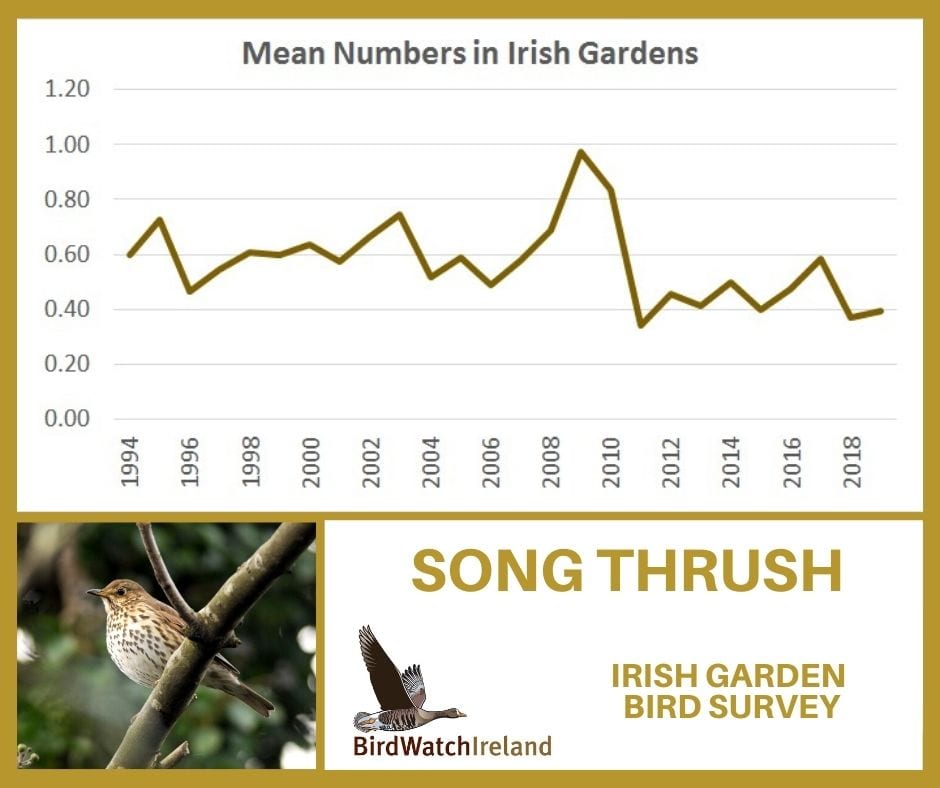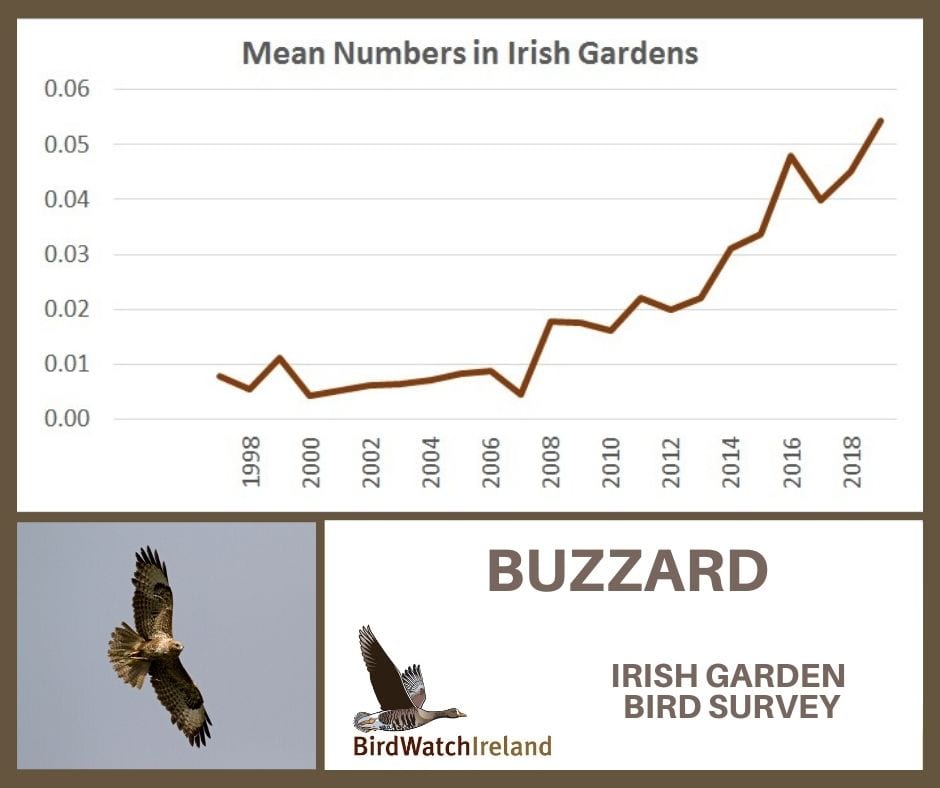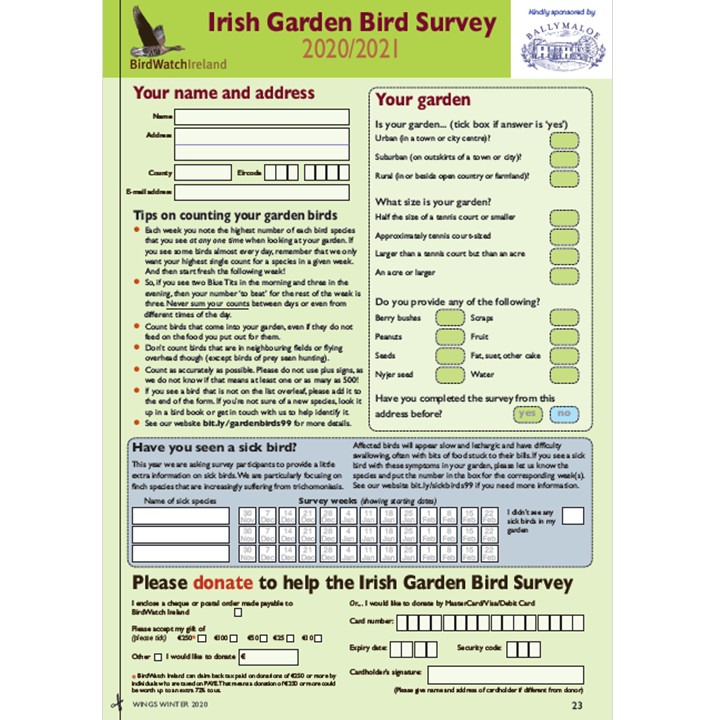We’re in the final week of this years Irish Garden Bird Survey! Annual surveys like this that are really vital to flag any problematic declines in some of our favourite species, and also to help us understand why certain species are increasing! We thought we’d take a look back at a few of the changes we’ve seen over the course of the survey, to remind you how important your counts are and how much we can learn from your data!
Please make sure to send your garden bird counts in as soon as possible when the survey finishes – either online, via email, or via post!
The graphs below are based on the mean number of each species in Irish Gardens on a weekly basis during the Irish Garden Bird Survey. With that in mind, the graphs are a product of 1) changing bird numbers, 2) changes in the number of gardens a species is found in and 3) changes to the number of weeks that a species is found in gardens. The graphs are intuitive though, because as bird numbers increase they’re found in more gardens and in more weeks, and similarly as other species decline then they occur in fewer gardens and fewer weeks during the survey!
The Irish Garden Bird Survey is kindly sponsored by Ballymaloe.
Goldfinch
Goldfinch have undoubtedly shown the biggest increase in Irish gardens in recent years. In the mid-1990’s they were in around 30% of gardens, ranking around 20-25th place each year, but they are now seen in over 85% of gardens each winter (top 10), with total numbers consistently increasing too. Previously they would only enter gardens to avail of fine seeds on weeds and flowers, but as people put out more and more palatable seeds (nyjer, sunflower hearts) the Goldfinches switched to feeders and have since firmly established themselves as a garden bird. Some have speculated that the recent decline of Greenfinches might have benefited Goldfinches to some extent as they face less competition for food.
Jay
The Jay is actually a member of the crow family, and it’s one of the few birds for which we have a distinct Irish subspecies. Their size and colour make them unmistakable, and like all crow species they’re fascinating to watch as they go about their business. They’re more of an ecological specialist than our other crows and are most strongly associated with broadleaf woodland (Oak in particular). Their numbers appear to be increasing in Ireland in recent years. Like the other crow species, they’re an intelligent bird and if they find a food source they’re going to return to it, so it’s no surprise that they’re taking advantage of the food in more and more (circa 10%) of Irish gardens. They won’t be able for your feeders but leave a handful of peanuts out early in the morning or late in the evening to get a glimpse!
Siskin
The trend for Siskins in Irish gardens is variable to say the least! They’re a small conifer woodland-specialist finch and really only come to gardens when their favourite tree seeds have run out late in the winter. In some years they don’t really visit gardens at all, or if they do it’s well into the spring, and these are the years where the Sitka Spruce seed crop (amongst others) has been particularly good and keeps them going into the new year. They mainly visit gardens in late January and February, often in large flocks, and make good use of both peanut and seed feeders. Because they associate so closely with woodland, they’re more likely to turn up in rural and suburban gardens than urban ones.
Long-tailed Tit
Two things are obvious from the graph below. The first is that, on average, more Long-tailed Tits have been using Irish gardens in the last 10 years than they did in the late 1990’s. The second is that there’s a lot of variation in the trend for Long-tailed Tits – a lot of ups, a lot of downs, and just when you think their numbers have stabilised for a couple of years there’s another spike or fall in numbers! If we were to look at trends for species such as Goldcrest, Treecreeper and Wren we’d see something similar. These birds are all tiny in size, they weigh less than 10g total, and they’re all predominantly insectivorous. All of that means that they’re the most susceptible of any bird species when cold weather hits – the increases are from them retreating to gardens in search of food during cold weather spells, and the decreases that tend to follow are due to a drop off in numbers that didn’t survive the previous winter. A few mild winters later and their numbers are back to normal, and then another cold winter hits and the cycle starts again! As long as they don’t meet too many successive cold years they’re able to cope with this sort of short-term fluctuation, and their breeding numbers have increased a bit in the last 25 years in a similar way to their winter numbers through the Irish Garden Bird Survey.
Greenfinch
This is a species that used to occur in around 90% of gardens each winter. Last winter it was 58% of gardens, the lowest levels ever seen in the survey. The reason is trichomoniasis – infection by a parasite that lodges in the throat of the bird and always results in death of the infected individual. This parasite isn’t anything new – it has long been known to occur in pigeons and birds of prey, but around 12 years ago the parasite ‘jumped’ to finch populations and Greenfinch were particularly hard hit. In Ireland the UK we’ve lost millions of Greenfinches to this parasite, and their numbers continue to fall. Into the future, it’s likely that Greenfinch numbers will undergo a boom-bust type pattern at a local level, where numbers in a part of the country increase over a couple of years, as they increase the parasite spreads more, then the numbers decrease again and the cycle starts again. The one thing you can do to help stop the spread is to wash your birdfeeders and water dishes regularly!
To learn more about trichomoniasis and sick finches, click here.
Linnet
This finch is very much considered a farmland bird. In the early days of the Irish Garden Bird Survey they were in less than 5% of gardens but more recently it has risen to around 10% and almost up to 12%. That increase hasn’t been uniform but has actually occurred more so in urban and suburban gardens compared to rural ones. The Bird Atlas showed some variation in their distribution in Ireland in winter and that they’ve lost some ground in the west but remained largely stable in east, and we know from the summer Countryside Bird Survey that they’re total numbers are doing pretty ok. It may be that the higher temperatures and ‘new’ feeding opportunities in built-up areas, couple with less competition from the declining Greenfinches, is working to the benefit of our Linnet population. Somewhat surprisingly given the similarity of our bird communities, Linnets are never really found in gardens in the UK.
Song Thrush
Most people would recognise a ‘thrush’, and the one you’re more likely to see is the Song Thrush (compared to the less common Mistle Thrush). This is a species that has definitely declined in gardens over the years, though there is some fluctuation in their population trend. The good and bad spells can be linked to winter weather conditions. Years with heavy snow and extended frosty periods make it very difficult for Song Thrushes to forage for worms, slugs and snails and their numbers take a huge hit after a cold winter, requiring a few mild winters to stabilise again.
Buzzard
There are plenty of negative stories when it comes to declines and loss of species, and the struggles of conservation, but this is a very positive one. Having been extinct here for the best part of 100 years, Buzzards naturally recolonised without the need for a reintroduction project, and slowly spread from the north and the east coast and are now back breeding in every county in Ireland. There won’t be much in your garden for them to eat, though you might be lucky enough to see one soaring overhead, or if you’re really lucky they might perch on a field gate or a telephone pole and inspect their surroundings!
The Irish Garden Bird Survey finishes on Sunday 28th Feb 2021. You can submit your results online via this link, or send a photo/scan of your form to gardenbirds@birdwatchireland.ie .
You can also post your form to us – the address is at the bottom of your form.
This winter we’re running a series of blogs like this one, filled with facts and figures about your favourite garden birds, click here for more.
We are hugely grateful to Ballymaloe for their sponsorship and support of the Irish Garden Bird Survey.
Click below to download your count form for this year’s Irish Garden Bird Survey.

